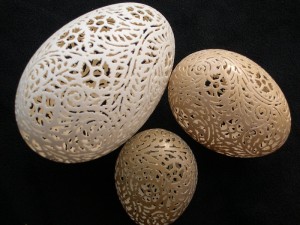Artist Uses Eggshells to Make Quirky Art
When artist Beth Ann Magnuson wakes up in the morning, she does not struggle through crowds to catch the subway. She also does not scarf down a Starbucks blueberry scone, still cold from the freezer, or down a double espresso Americana.
Rather, Magnuson awakens in her Bishop Hill home to the sound of wind rustling through the trees. For breakfast, she gathers fresh eggs from farm-raised fowl. She recreates the ones she does not eat by drilling an intricate design into the eggs’ shells or uses the shells to redecorate worn pieces of furniture.
“Ms. Magnuson’s work is ephemeral and is of a seasonal character,” commented Marsha Carleson, co-owner of Outsider Gallery where Magnuson’s art has been displayed since 2008.
The other owner of Outsider Gallery, Steve Carleson, also enjoys Magnuson’s work. His favorite pieces are her dolls that are covered in a green, moss-like material.
“If we personally like it, [we put the artist’s work in our gallery],” Carleson commented.
The Carlesons and Magnuson live in the small rural community of Bishop Hill in Illinois. Magnuson was drawn to Bishop Hill for its historic charm and community of like-minded artisans.
“Bishop Hill is a town of makers,” Magnuson explained. “We’re really trying to suck in people who are similar in thought that will dedicate life to their craft or their art.”
Before moving to Bishop Hill, Magnuson graduated from Stony Brook University in New York with an art degree.
“I wasn’t the ‘hang-the-art-on-the-wall’ kind of artist,” Magnuson said. “I was a nature girl and I spent most of my adult life finding a place to commune with nature.”
That place has become Bishop Hill, known to locals by its tagline, “Utopia on the Prairie.” Since moving there, Magnuson has built the Feathered Nest and Windy Corner Farm, her home and inspiration for her art.
“Magnuson uses organic found elements of nature and recycled castoffs from manufacture to communicate the often-overlooked beauty in the world that surrounds us,” Marsha Carleson commented.
“It’s quirky art,” Magnuson said. “It’s odd art, but it’s always based in nature.”
Magnuson’s Victorian Lace Eggs are some of the most intricate and unusual of her for-sale art. To make them, she first drains the egg by drilling a tiny hole in the bottom. She then stencils a design onto the shell. Finally, she uses a high-speed carving tool to drill the design into the egg. The result is a lace-like, delicate design.
“I always loved the look of old lace,” said Magnuson, describing the inspiration for her egg art. “My grandmother had gobs of it that she gave me.”
Surprisingly, Magnuson is not the only artist interested in decorating and designing eggs. National and international egg art guilds have developed to support this age-old hobby and support a network of egg artists.
Magnuson discovered this unusual niche 20 years ago through artist Beverly Harder, a name fairly well known in the egg art community. Upon inheriting her uncle’s dental tools, Harder found that the high-speed instruments were perfect for working with materials like eggshells. Harder taught Magnuson how to use the tools and showed her the process of designing an egg.
“She was very gracious,” Magnuson recollected.
Magnuson’s other art includes decorative wreaths, silhouettes, and most recently, Christmas trees made out of shredded aluminum cans.
“[My work] is an expression of something that I love that I want to share with people,” Magnuson said, “and get them to share the same ‘aha’ that I do.”
“That I have in common with artists that pour their soul into a canvas,” she added.
To see more of Magnuson’s work, visit www.windycornerfarm.com. To see how she makes her eggs, watch the “Samples of Hand Carved Eggs by Beth Ann Magnuson” video on YouTube.


